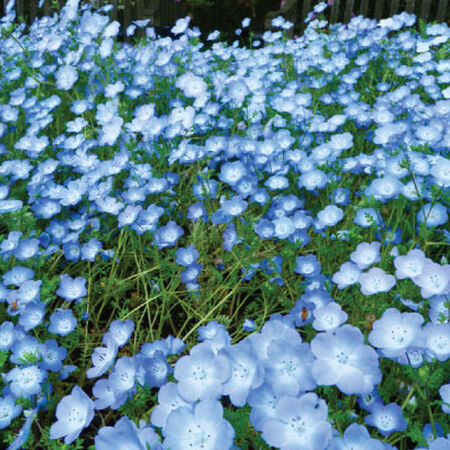Baby Blue Eyes, Nemophila Seeds
Key Attributes
Key Attributes
Product Details
Weight
0.01Depth
0.15Height
4.5Width
3.25Plant Height
3-6"Botanical Name
Nemophila menziesiiSeed Type
SeedAdditional Characteristics
Attracts PollinatorsSeeds Per Gram
190Seeds Per Pound
86,096Packet
500 SeedsSow Depth
1/8"Seeds Per Ounce
5,381Breed
Open-pollinatedSun
Partial ShadeGrowing Conditions
Container FriendlyLife Cycle
AnnualSow Method
TransplantCategories
FlowersDays To Maturity (# Days)
65Components
Growing Instructions
![]() Learning Download: How to Grow Nemophila
Learning Download: How to Grow Nemophila
Nemophila is an annual flower that grows well in a wildflower garden or rock garden. They will attract butterflies and bees to the garden. Nemophila originated in California.
Before Planting: Begin Nemophila seeds indoors in peat pots six to eight weeks before setting them outdoors.
Planting: Plant in mid-March, when a frost may still be possible. In warmer climates, Nemophila should be planted in the late fall.
Watering: Water Nemophila frequently to keep the soil moist.
Fertilizer: There is no need to fertilize since Nemophila often is grown as wildflowers.
Days to Maturity: In hotter climates, Nemophila will bloom midspring, but in cooler climates it will bloom through the summer.
Harvesting: To harvest seeds for future planting, cut off the heads of the plants after blooming and dry them in a paper bag to use the following spring.
Tips: Since Nemophila are one of the first annual to grow in the spring, continue to direct sow every three weeks to enjoy the blooms for a longer period of time.
Shipping Schedule
Our Seed Promise
 "Agriculture and seeds" provide the basis upon which our lives depend. We must protect this foundation as a safe and genetically stable source for future generations. For the benefit of all farmers, gardeners and consumers who want an alternative, we pledge that we do not knowingly buy or sell genetically engineered seeds or plants.
"Agriculture and seeds" provide the basis upon which our lives depend. We must protect this foundation as a safe and genetically stable source for future generations. For the benefit of all farmers, gardeners and consumers who want an alternative, we pledge that we do not knowingly buy or sell genetically engineered seeds or plants.
The mechanical transfer of genetic material outside of natural reproductive methods and between genera, families or kingdoms, poses great biological risks as well as economic, political, and cultural threats. We feel that genetically engineered varieties have been insufficiently tested prior to public release. More research and testing is necessary to further assess the potential risks of genetically engineered seeds. Further, we wish to support agricultural progress that leads to healthier soils, to genetically diverse agricultural ecosystems, and ultimately to healthy people and communities.
To learn more about the "Safe Seed Pledge" please visit www.councilforresponsiblegenetics.org.

